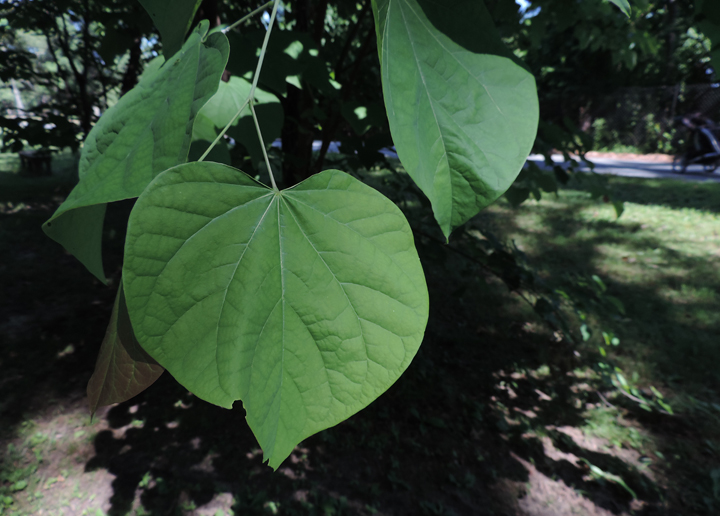Eastern Redbud
(Cercis canadensis L.)
Decscription
Eastern redbud is a deciduous tree that is a member of the pea family (Fabaceae)¹. This tree can grow to be around 15-30 feet in height and spreads around 15 to 25 feet’. The most striking feature of eastern redbud is the bright pink flowers that bloom in early spring before leaf-out¹. Beginning in March and ending in May, eastern redbuds are one of the first trees to start to grow flowers in spring¹. The flowers come in bright shades of pink to reddish-purple colors and can bloom on twigs, branches, and trunks¹. They are capable of growing flower buds on the bark of the tree, which is an uncommon feature and is typically only seen in trees that grow in temperate climates². The bark on an eastern redbud tree is a gray color with twigs that are typically reddish brown³. The leaves of eastern redbud include alternating heart-shaped leaves that have a light green color³. The twigs form a zig-zag between leaves ¹. Fruits are flat pods, 3.5 inches long that contain 4 to 10 small, dark brown seeds ¹.

Radish-brown bark of eastern redbud. @ B. Hubick*, Maryland Biodiversity Project 7

Flowers of eastern redbud. @ B. Hubick* 2014, Maryland Biodiversity Project 7

Leaves of eastern redbud. @ B. Hubick*, Maryland Biodiversity Project 7

Fruits of eastern redbud. @ J. Warren & C. DeWitt (some rights reserved, CC BY-NC), North Carolina State Extension 9
Distribution
The eastern redbud tree is commonly distributed throughout eastern America and southern areas of the Great Plains¹. It ranges from New Jersey and Pennsylvania to Michigan, Nebraska, Texas, and Florida with a disjunct population in South Texas and Mexico 4. Many factors allow eastern redbuds to have a wide distribution range. Eastern redbud is commonly seen as an understory tree, which means that it can grow under taller shade trees5. It is also able to grow in a wide range of soil pH values and soil textures4, but grows best with a pH above 7.5 ¹. Redbuds are most commonly seen on southern slopes, which are areas that have more sunlight available and less competition4. Eastern redbud is found throughout Maryland except on the lower Eastern Shore 7.

Natural range of eastern redbud 8
Wildlife Importance
The flowers that bloom on eastern redbuds are very important to different types of wildlife, especially to pollinators and animals that use nectar as a food source. Both hummingbirds and butterflies, such as Henry’s elfin butterfly, use the eastern redbud as a source of nectar5, and the pollen is used by honeybees¹. Eastern redbud may be used as a food source for other types of wildlife as well. In cases where it is used as food, it is typically used as an emergency food source¹. Animals such as deer and livestock can graze on the foliage and twigs¹. Squirrels and several types of birds can eat the seeds. In addition to the seeds, squirrels may also eat the buds and bark¹.
Economic Importance
Because of the redbud’s beautiful pink flowers, this tree is a popular choice for landscaping and gardens. This is also supported by its relatively small size which means it is a safer tree to plant near homes. In addition, multiple parts are edible and can be used in various dishes. The twigs and the flowers are used in teas, and the flowers can be fried and eaten¹. The wood from an eastern redbud tree can also be used in woodworking to make various objects, including wooden bowls and handles².
Threats
There are not many threats to the eastern redbud. This tree may be impacted by several varieties of insects. This includes insects that function as wood borers as well as ones that eat the leaves of the tree or extract the juices4. However, this is not a major problem because the damage is rarely severe 4. Eastern redbud is susceptible to various diseases such as Verticillium wilt and Botryosphaeria canker 4.
Interesting Facts
- Historically, the bark of eastern redbuds has been used to treat various illnesses. For example, native Americans would use the bark in tea as a treatment for whopping cough¹.
- United States Presidents also have a history of enjoying the redbud tree. Both George Washington and Thomas Jefferson are reported to have planted these trees at their homes³. George Washington in particular wrote about this tree in his journal and supposedly spent many hours planting seeds he obtained from a nearby forest in his garden6.
- In 1937 eastern redbud was selected as the state tree of Oklahoma after some controversy over the tree’s second name, which is the Judas tree 4. This name is related to the beliefs about the connection between the biblical figure Judas and a type of redbud tree, which is why Israel gave this tree protective status 6.
References
- USDA NRCS Plant Fact Sheet: Eastern Redbud
- Butler Soil & Water Conservation District Native Spotlight: Eastern redbud
- GrowIt Buildit blog: Complete Guide to Redbud Tree–What You Need to Know
- USDA Forest Service Silvics, Vol. 2–Hardwoods: Cercis canadensis
- American Beauties Native Plants: Eastern redbud
- Chasing Trees: Redbud
- Maryland Biodiversity Project: Eastern redbud
- Wikipedia: Cercis canadensis
- North Carolina State Extension: Cercis canadensis
* Imaged used with permission of photographer.
Contributed by A. Klein
